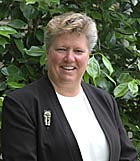May 30, 2005
Making sense of the campus's LRDP project
In an effort to provide additional information to the campus
community about the process of updating the campus’s Long
Range Development Plan, Currents is periodically discussing
various aspects of the LRDP with campus personnel.

Jean Marie Scott
Photo: Louise Donahue
|
This month’s Q&A is with Jean Marie Scott, associate
vice chancellor of Colleges and University Housing Services.
AVC Scott is an expert on housing issues related to the planning
project.
Q. How would you assess UCSC’s record of meeting students’
housing needs?
A. UCSC has one of the finest portfolios of housing
inventories in the nation. During the past five years alone,
the campus has added housing for approximately 2,000 additional
students, and our housing options are enhanced by an incredible
array of dining services and coffee shops. The backbone of UCSC
housing is our system of residential colleges, which transform
a physical living experience into a vibrant and engaging learning
experience for our students.
During this past fall quarter, UCSC housed approximately 44
percent of our undergraduate students in university-sponsored
housing. That’s the highest percentage in the UC system
and one of the highest in the nation for public universities.
Q. What aspects of housing are most challenging for a campus
like UCSC that is growing?
A. On UC campuses, housing is a self-supporting enterprise,
which means that 100 percent of the costs for operations and
debt must be covered by the rental rate structure and other
revenue generated from the enterprise. As we have added significant
amounts of housing to our inventory in recent years, the debt
for these units has added substantially to our overall rate
structure. We spread this debt over a long period of time so
that the impact on rates is gradual. But the recent acceleration
of UCSC housing growth has placed a strain on our rate structure.
It is also critical to understand that our ability to grow
university housing is dependent on conditions in our regional
housing market. In other words, we try to ensure that our rate
structure doesn’t make it so that on-campus housing is
too expensive to compete with regional housing. In addition
to considering the availability and price of local housing,
before we begin every project we conduct an extensive demand
analysis to forecast absorption rates for the new housing. National
research models, as well as recent research conducted on our
campus, suggest that the average yield of undergraduate students
into university housing at four-year public institutions may
top out at about 50 percent. In other words, due to a variety
of developmental, financial, and social reasons, even if the
campus were to build housing capacity to 70 percent of undergraduates,
the likely yield might not exceed 50 percent.
Q. What is the latest on UCSC’s efforts to provide
housing for faculty and staff?
A. The campus is moving into the last set of approvals
for the Ranch View Terrace Project. Now that we have the approval
of the Regents, groundbreaking is scheduled for August 2005.
This project is planned to deliver 45 single-family homes in
Phase I of construction and a total of 39 homes in Phases II
and III.
 Email this story
Email this story
 Printer-friendly version
Printer-friendly version
 Return to Front Page
Return to Front Page